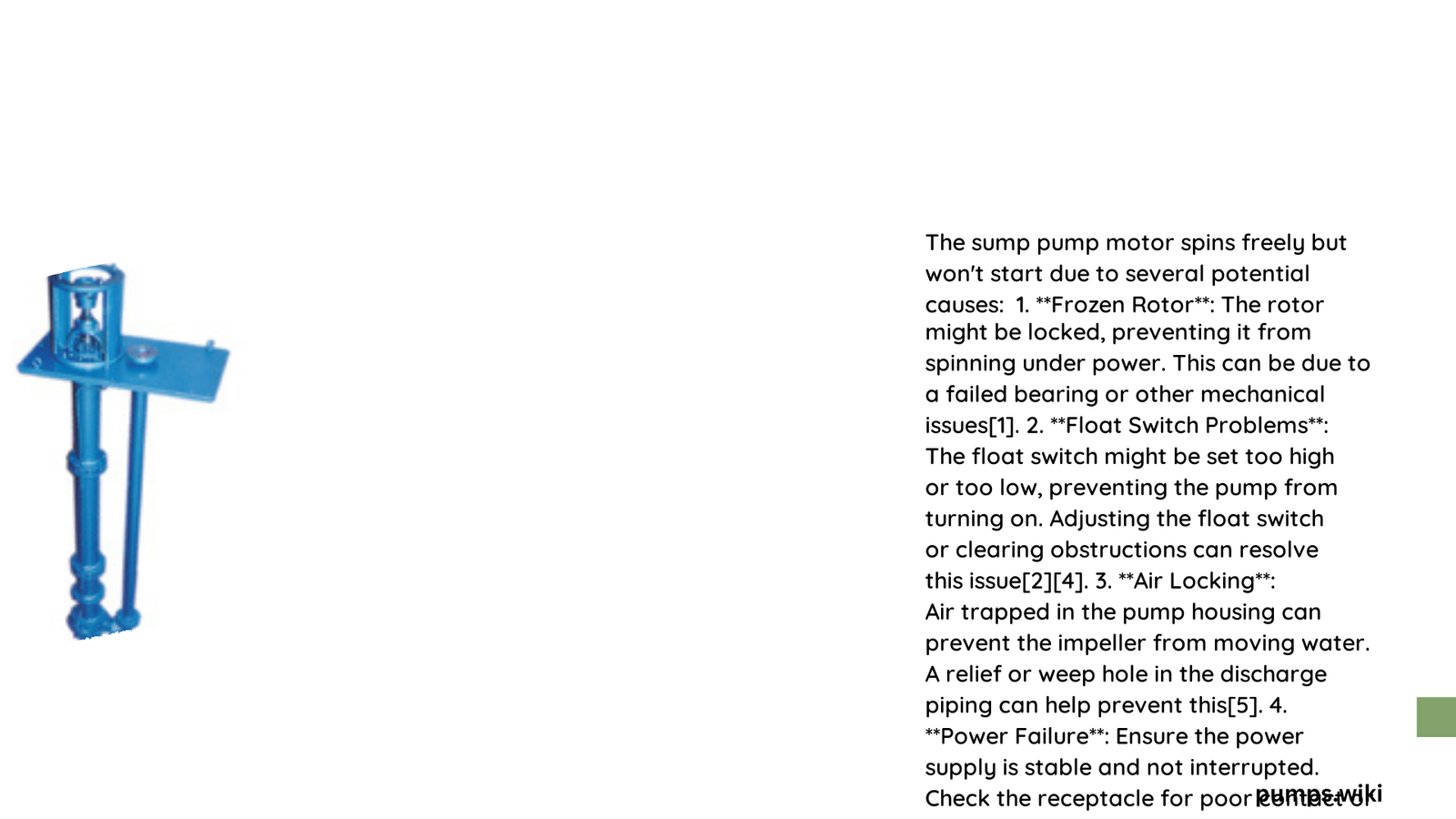A sump pump motor that spins freely but fails to start is a common issue that can lead to basement flooding if not addressed promptly. This problem often stems from electrical issues, switch malfunctions, or mechanical failures. Understanding the root cause and implementing the right solution is crucial for maintaining a functional sump pump system and protecting your home from water damage.
What Are the Common Causes of a Sump Pump Motor Spinning Freely Without Starting?
Several factors can contribute to a sump pump motor spinning freely without starting:
- Electrical problems
- Faulty capacitor
- Damaged float switch
- Clogged impeller
- Worn-out motor bearings
Let’s explore each of these potential causes in detail.
How Do Electrical Issues Affect Sump Pump Motor Performance?
Electrical problems are often the culprit when a sump pump motor spins freely but won’t start. Here are some key points to consider:
- Power Supply: Ensure the pump is receiving adequate power. Check if the circuit breaker has tripped or if the GFCI outlet has been activated.
- Wiring: Inspect all electrical connections for signs of wear, damage, or loose connections.
- Voltage: Use a multimeter to verify that the pump is receiving the correct voltage as specified by the manufacturer.
What Role Does the Capacitor Play in Sump Pump Motor Function?
The capacitor is a crucial component in the sump pump motor’s starting mechanism. When it fails, the motor may spin freely but fail to start. Here’s what you need to know:
- Function: The capacitor provides the initial boost of energy needed to start the motor.
- Signs of Failure: A humming noise without motor start-up or intermittent operation can indicate a faulty capacitor.
- Testing: Use a multimeter to measure the capacitance and compare it to the rated value on the capacitor.
How Can a Faulty Float Switch Prevent the Sump Pump from Starting?
The float switch is responsible for activating the pump when water levels rise. A malfunctioning switch can prevent the motor from starting even if it spins freely:
- Stuck Switch: Debris or mineral buildup can cause the float to become stuck in one position.
- Electrical Issues: Corroded or damaged wiring in the switch can interrupt the signal to start the pump.
- Mechanical Failure: The internal mechanism of the switch may wear out over time, preventing proper activation.
What Impact Does a Clogged Impeller Have on Sump Pump Operation?
A clogged impeller can create resistance that prevents the motor from starting, even if it spins freely when manually turned:
- Debris Accumulation: Sediment, small rocks, or other debris can become lodged in the impeller.
- Reduced Efficiency: Even if the pump starts, a partially clogged impeller can significantly reduce pumping efficiency.
- Increased Wear: Attempting to start with a clogged impeller can put additional stress on the motor and other components.
How Do Worn Motor Bearings Affect Sump Pump Performance?
While worn bearings may allow the motor to spin freely, they can still prevent proper start-up:
- Increased Friction: Worn bearings create additional friction, making it harder for the motor to overcome initial inertia.
- Noise: Grinding or screeching noises during operation can indicate bearing issues.
- Heat Generation: Excessive heat from worn bearings can trigger thermal protection, preventing motor start-up.
What Are the Steps to Diagnose a Sump Pump Motor That Spins Freely but Won’t Start?

Follow these steps to diagnose the issue:
- Check Power Supply:
- Verify that the pump is plugged in and the circuit breaker is not tripped.
-
Test the outlet with another device to ensure it’s functioning.
-
Inspect Float Switch:
- Manually lift the float switch to see if the pump activates.
-
Clean any debris or buildup around the float.
-
Examine the Impeller:
- Unplug the pump and remove the bottom screen.
-
Check for and remove any debris blocking the impeller.
-
Test the Capacitor:
- Use a multimeter to check the capacitor’s capacitance.
-
Look for signs of physical damage or swelling.
-
Assess Motor Bearings:
- Listen for unusual noises when attempting to start the pump.
- Feel for excessive heat around the motor housing.
What Are the Recommended Solutions for a Sump Pump Motor That Spins Freely but Won’t Start?
Based on the diagnosis, consider the following solutions:
| Problem | Solution | Estimated Cost | Difficulty |
|---|---|---|---|
| Electrical Issues | Repair or replace wiring, check circuit breaker | $50 – $200 | Moderate |
| Faulty Capacitor | Replace capacitor | $10 – $50 | Easy |
| Damaged Float Switch | Clean or replace float switch | $20 – $100 | Easy to Moderate |
| Clogged Impeller | Clean impeller and pump housing | $0 (DIY) | Easy |
| Worn Motor Bearings | Replace entire pump (usually more cost-effective than bearing replacement) | $100 – $500 | Moderate to Difficult |
How to Replace a Sump Pump Capacitor:
- Disconnect power to the sump pump.
- Locate the capacitor (usually near the motor or in the control box).
- Note the capacitor’s rating and obtain an exact replacement.
- Carefully disconnect and remove the old capacitor.
- Install the new capacitor, ensuring proper connection.
- Reassemble any removed parts and restore power.
- Test the pump to ensure proper operation.
When Should You Consider Professional Help?
While many sump pump issues can be addressed by homeowners, certain situations warrant professional assistance:
- Lack of electrical expertise
- Repeated failures after DIY attempts
- Extensive water damage requiring immediate action
- Pump is under warranty (DIY repairs may void coverage)
Remember, a properly functioning sump pump is crucial for protecting your home from water damage. If you’re unsure about any repair steps or if the problem persists, don’t hesitate to contact a professional plumber or sump pump specialist.
